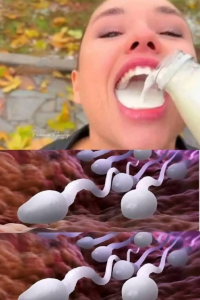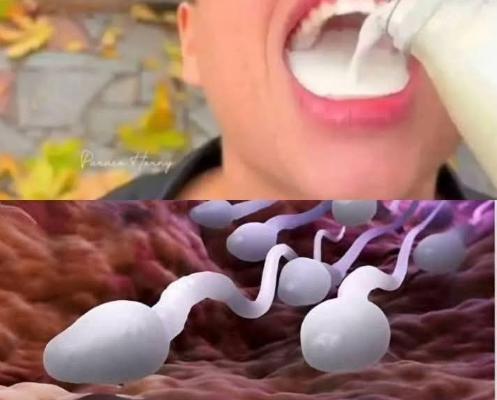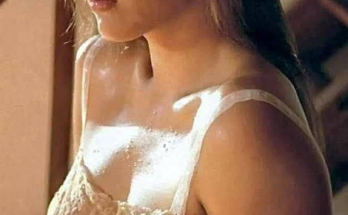
What Doctors Really Say: The Truth Behind Viral Claims About Semen and Health
In the age of viral posts and attention-grabbing headlines, it takes only seconds for misinformation to spread—and only a few minutes for millions of people to believe something that has no scientific basis at all. One of the most persistent, sensational claims circulating across social media involves the idea that swallowing semen supposedly provides dramatic health benefits, disease protection, or some kind of miracle effect on the body. According to these posts, “doctors reveal” astonishing discoveries.
But what do real physicians and researchers actually say?
The truth is far less dramatic—and far more interesting—than the myths.
The Viral Headline Problem
Every week, it seems a new clickbait post hits timelines with bold, breathless declarations: that certain bodily fluids cure depression, boost immunity, balance hormones, or even prevent illness. There’s usually a grain of truth twisted into a mountain of exaggeration. Sometimes the claims are based on outdated studies, misinterpreted experiments, or quotes taken wildly out of context.
Doctors who see these headlines often shake their heads, because they know how misinformation preys on curiosity, taboo topics, and shock value. The reality is that reputable medical sources simply don’t make sweeping statements about dramatic benefits from sexual fluids—especially not the way viral posts frame them.
What Semen Is Actually Made Of
Stripping away the sensationalism, semen is a biological fluid composed primarily of:
-
water
-
proteins
-
enzymes
-
sugar (mainly fructose)
-
trace vitamins and minerals
In other words, its composition is far more ordinary than most people think. It isn’t magical. It isn’t toxic. And it isn’t a miracle supplement.
Doctors emphasize that the presence of micronutrients, such as zinc or magnesium, does not mean the substance acts like a vitamin pill. The quantities are extremely small—far too small to create measurable health effects.
In fact, nutritionists regularly point out that a single serving of fruit or a glass of water has far more nutritional benefit than any of the substances often dramatized in viral claims.
Where the Myths Begin
Most myths begin with science that is either:
-
Overly simplified,
-
Misquoted, or
-
Completely removed from context.
For example, years ago a study explored how certain proteins in semen interact with the immune system during conception. This research focused on the body’s reproductive pathways—not general health. But online, the nuance disappeared. Instead, headlines proclaimed that “scientists discover massive immune benefits from semen.”
Another example: A small study suggested that trace hormones in semen might have mood-related effects when absorbed vaginally. The study was limited, not widely replicated, and did not involve ingestion. Yet the internet twisted it into claims about anti-depressant effects.
Doctors consistently remind people that correlation does not equal causation, and isolated research does not become universal truth.
Real Health Risks and Real Safety Considerations
While viral posts make sensational claims about benefits, responsible sources focus on the importance of safety. Medical professionals stress that:
-
The biggest risk involving semen is sexually transmitted infections.
-
These risks exist regardless of the method of exposure.
-
No health “benefit” negates these risks.
Doctors want people to have honest, stigma-free conversations about safe practices, consent, and joint decision-making. They also warn that online mythologies can pressure people into choices they don’t fully understand.
So while the internet may push the message that certain acts are “healthy,” medical professionals emphasize that the health implications—positive or negative—depend on safety, trust, consent, and context, not on viral claims.
Why These Myths Persist
There are several reasons these narratives spread so quickly:
1. Taboo sells.
Anything related to sexuality captures attention. People click, react, and share before fact-checking.
2. Scientific language sounds authoritative.
Phrases like “studies show” or “experts reveal” often accompany no actual citations.
3. The human brain loves shortcuts.
The idea of a simple, surprising health boost is far more appealing than the reality of balanced diet, sleep, and exercise.
4. Humor and shock value fuel virality.
Some people share these posts because they’re funny. Others share them because they’re scandalous. Either way, the spread is massive.
What Doctors Actually Recommend
When you strip away the sensationalism, here are the consistent points medical professionals make:
-
No major health organization claims that consuming sexual fluids provides medical benefits.
-
No valid research supports miracle health claims.
-
Safe practices, mutual consent, and clear communication are the priorities.
-
If you want health benefits, a balanced diet and lifestyle matter far more than internet myths.
Some physicians also point out that overly focusing on “health benefits” can diminish the importance of emotional, relational, and consensual aspects of intimacy—elements that matter far more for long-term well-being.
How to Spot Misinformation in the Future
Doctors and science communicators suggest three quick filters to apply whenever a shocking health claim appears online:
1. Does it cite actual research?
Real studies have authors, dates, journals, and links.
2. Is the claim disproportionately dramatic compared to the evidence?
When small facts are inflated into giant promises, that’s a red flag.
3. Does the headline use fear, shock, or sexual content to drive clicks?
If so, approach with caution.
Becoming a critical reader is one of the healthiest choices anyone can make.
The Bottom Line
Despite all the dramatic headlines, medical experts agree on one thing: there is no scientific evidence that swallowing semen delivers significant health benefits. The myths are products of exaggeration, shock value, and misinterpreted research. The safest, healthiest approach is not to chase viral claims but to rely on factual, responsible sources.
For doctors, the real priority is encouraging understanding, communication, and safe practices—not feeding misinformation.
When the noise of the internet fades, what remains clear is this:
Good health is built on informed choices, not sensational headlines.

